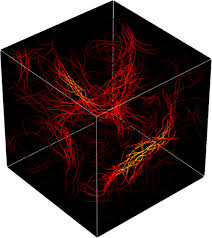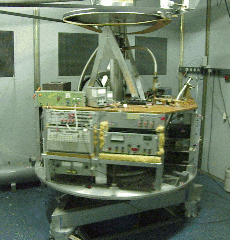Quantum Fluids
 PhD place available!
PhD place available!
Applications are welcome for EPSRC-funded PhD projects, beginning in autumn 2017, aimed at experimental investigation of Quantum Turbulence in superfluid 4He in the T=0 limit. Enquiries: Andrei Golov (andrei.golov@manchester.ac.uk, room 2-13) and Paul Walmsley (paul.walmsley@manchester.ac.uk, room G-1 in the Schuster building).
(image: numerically simulated bundles of quantised vortices from http://jasonlaurie.com/blog/index.php/category/quantum-turbulence/)
Introduction to the superfluidity of Helium
We study quantum fluids, i.e. liquids at sufficiently low temperatures so that the quantum properties of the particles forming the liquid prevail (for example, the behaviour of fermions is markedly different from that of bosons at these temperatures). In reality, there are only two types of quantunm fluids available for experimentalists: electrons in metals and liquid helium.
Electrons are fermions; they can undergo transitions into superconducting or magnetically ordered states - this depends on very complicated details of their interaction with particular ions of the solid, crystalline lattice and its defects and impurities. In contrast, liquid helium is a pure and simple liquid, yet at low temperatures it can show a great variety of new properties and orders: sometimes very similar to that of electrons in superconductors or normal metals but sometimes special to a particlar isotope of helium.
Isotopes of Helium
There are two isotopes of helium: 4He (boson) and 3He (fermion). Owing to quantum effects both isotopes remain liquid to absolute zero (unless you pressurise them above some 30 atm). Both liquids show the phenomemon of superfluidity (fluid flow without viscosity) at sufficiently low temperatures (2 K and 2 mK respectively). Nobel prizes have been awarded for the experimental discovery of both superfluids (1978 and 1996) and theoretical explanation of their properties (1962 and 2003). Both liquids are excellent systems for testing our understanding of the quantum behaviour of condensed matter from first principles.
Liquid 3He is the purest substance available for study and whilst being the simplest Fermi superfluid known it exhibits a wide array of interesting phenomena which result directly from the various symmetries which are spontaneously broken when its different superfluid states form. On the other hand, in superfluid 4He only one symmetry (gauge invariance) is broken leading to only one possible type of topological defects - one-dimensional quantized vortices. This, together with the relative ease of reaching the temperatures at which superfluidity in 4He is well-developed, T < 1K, makes liquid 4He an ideal substance in which to investigate the dynamics of tangles of quantized vortices, i.e. Quantum Turbulence. We are actively involved in the research on Quantum Turbulence in the zero-temperature limit. This is a new distinct type of turbulence that resembles classical hydrodynamic turbulence at large length scales and wave turbulence at short scales.
 Special acknowledments
Special acknowledments
Our success would be impossible without the support by our technicians, Mr Mark Sellers and Mr Paul Richardson.